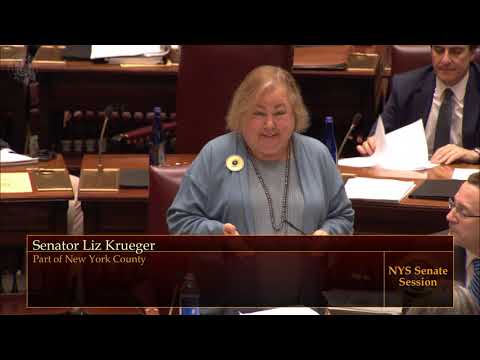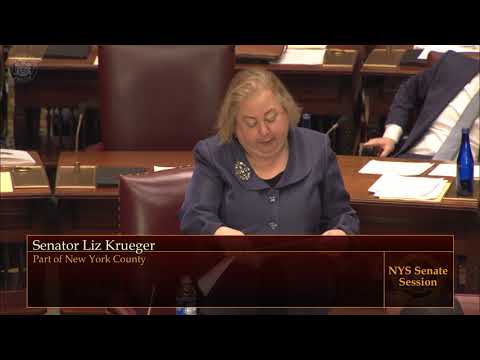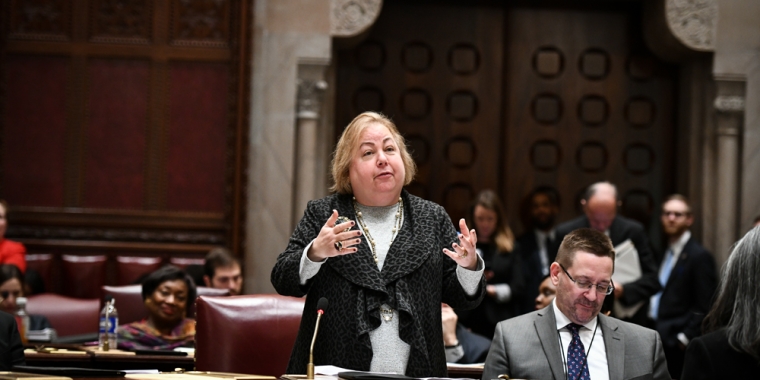
Testimony of State Senator Liz Krueger Before the New York State Department of Environmental Conservation Regarding the Draft Supplemental Generic Environmental Impact Statement on High-Volume Hydraulic Fracturing
Liz Krueger
December 1, 2011
My name is State Senator Liz Krueger and I represent the 26th Senate District, which includes the East Side and Midtown areas of Manhattan.
I want to thank you for providing me with this opportunity to testify on the New York State Department of Environmental Conservation’s (DEC) proposed Draft Supplemental Generic Environmental Impact Statement (SGEIS) for High-Volume Hydraulic Fracturing.
I would like to start by saying, that while I appreciate that the DEC has extended the comment period to allow for more time to gather public input, the 30 day extension is not adequate. As you can see by the sheer volume of public participation in New York City alone, New Yorkers have a strong opinion on the future of fracking in their state and they deserve to be heard. I would like to request that the DEC extend the public comment period for another 90 days, giving the public a full 180 days to review and submit comments on the SGEIS.
This past weekend, in an article published by the New York Times on November 25th, Governor Andrew Cuomo was quoted as saying the following in regards to hydrofracking: “Let’s get the facts. Let the science and the facts make the determination, not emotion and not politics.”
Well, I couldn’t agree more with Governor Cuomo. However, these are the facts I’m looking at and the reality is that they lead to more questions than they do answers:
- Fact: Evidence from other states demonstrates that there are significant environmental risks associated with hydrofracking. The evidence of the dangers of hydrofracking is clear, and every few months a new incident highlights the risk. In April a well blowout in Bradford County, Pennsylvania forced evacuations after 30,000 gallons of fluid from the well inundated area fields and stream. Last year two well explosions in Pennsylvania killed three people.
In Pennsylvania, Alabama, and Wyoming, there have been numerous reports of groundwater contamination. In Ohio, tap water caught fire after an accident at a hydrofracking well. Additionally, a series of articles produced by the New York Times has revealed that studies conducted by the Environmental Protection Agency show that the wastewater produced in hydrofracking is far more dangerous than previously reported.
So I ask, with all of these previous disasters, why the DEC is so confident that no such problems will occur in New York? Even with stricter regulations in place, it only takes one accident for there to be catastrophic effects on the surrounding community and potentially all of New York.
- Fact: There is no guarantee that the chemicals used in the cocktail of hydraulic fracturing fluids are safe for human health because we have not been able to ban carcinogenic materials from the process. In 2010 I introduced legislation that would greatly increase the transparency in the hydrofracking process by requiring the full disclosure of the materials infused in hydraulic fracturing fluids and would prohibit the use of chemicals deemed to “pose a risk to human health.” Therefore, we could know for a fact that only safe materials are used but this legislation remains stalled because the natural gas industry has fought tooth and nail to protect what they call “trade secrets.” While I understand that drilling companies will be required to disclose fluid contents to DEC, I believe these disclosures must be revealed to the public as well.
So I ask, without such full disclosure, how can we adequately examine and determine the scientific facts? How can we come to decisive conclusions if we don’t even know what we’re working with? And why would banning carcinogenic materials from the hydrofracking process be anything but a sound scientific decision? If the materials used in hydrofracking pose no risk to human health then why is it such a big deal to back toxic substances? We cannot allow any process to go forward when we don’t know what chemicals are being used or what the outcome of those chemicals will be on our environment. If we can’t make it safe, we cannot do it. And if we can’t make it transparent, how can we believe it’s safe?
- Fact: The United States Geological Survey wrote in the FAQ “Earthquakes, Faults, Plate Tectonics, Earth Structure,” that “Earthquakes induced by human activity have been documented in a few locations in the United States, Japan and Canada. The cause was injection of fluids into deep wells for waste disposal and secondary recovery of oil, and the use of reservoirs for water supplies.” There is, therefore, enough reasonable scientific evidence to cause concern that hydrofracking could lead to seismic activity. In fact, recent reports indicate that government of the City of New York is concerned about the risk of small underground earthquakes caused by fracking on the infrastructure of NYC’s water system.
So I ask, why has the DEC failed to investigate this matter further? Where are the science and the facts that indicate we have no concerns about industry created earthquakes here in New York State?
- Fact: While the Economic Assessment Report for the draft SGEIS dedicates most of its analysis the positive financial implications of hydrofracking in New York, it barely skims the surface of the negative impacts. In fact, it is not until the very last paragraph of the very last page that the report indicates that, “local governments would also experience some significant negative fiscal impacts as a result of the development of natural gas reserves in the low-permeability shale.” While the report states that, “Additional road construction, improvement, and repair expenditures would be required as a result of the in¬creased truck traffic that would occur,” it provides no further estimates on the what these expenditures may be. What appears to have been ignored is a Draft Discussion paper by the DOT titled The Transportation Impacts of Potential Marcellus Shale Gas Development. The paper underscores that increased truck traffic from gas drilling will lead to annual costs of $121-$222 million for local roads and $90 - $156 million for State roads because of the need to reconstruct hundreds of miles of roads and scores of bridges. It also goes on to say, “There is no mechanism in place allowing State and local government to absorb these additional transportation costs without major impacts to other programs and other municipalities in the State.”
So I ask, were these details never fully analyzed in the SGEIS or were they simply left out for the sake of painting a better economic picture? Because when the Governor said we should look at the facts I would assume he meant we should look at ALL of the facts, not just some.
- Fact: In the Bakken Shale in North Dakota, oil companies are engaging in a practice called flaring where they burn off natural gas, literally treating it as waste, to get to more lucrative oil. According to the New York Times, more than 100 million cubic feet of natural gas is burned each day, which is 30% of the natural gas produced in North Dakota.
So I ask, if Natural Gas is an “economic savior” for Upstate and Western New York and worth the lofty valuations that the companies lobbying in its favor suggest - and to be clear I DO believe we must do something to increase business opportunities in these areas - then why would other oil companies be treating it with such disregard, literally burning it away? What happens if or when drilling for natural gas is no longer a viable economic source for oil companies? What will happen to the hundreds, if not thousands, of wells already built?
- This leads to another fact: We do not know how much natural gas the Marcellus Shale actually contains. Nine years ago, the Energy Department projected that there was 410 trillion cubic feet of natural gas in the Marcellus Shale. This year, the U.S. Geological Survey released estimates that the same shale contains 84 trillion cubic feet, a reduction of 80%. Clearly the disparity in predictions underlines the fact that we do not know how much natural gas is actually embedded in the Marcellus Shale.
- Just as pertinent a fact: we do not know if drilled wells will actually meet the projected lifespan of 30 years, as predicted by the draft SGEIS. Therefore the projections by which most of the economic impact is based are not facts, they are based off of limited data and a certain amount of guesswork.
So I ask, how can the DEC honestly stand behind the economic projections with so much uncertainty plaguing the process? As stated in a New York Times story that uncovered hundreds of industry emails and internal documents on June 25, 2011 “energy executives, industry lawyers, state geologists and market analysts voice skepticism about lofty forecasts and question whether companies are intentionally, and even illegally, overstating the productivity of their wells and the size of their reserves.”
Based on these facts, and many more questions, I do not believe that the science is there at this point in history to support high-volume hydraulic fracturing. I’ll accept the fact that technology keeps moving forward and that sometime in the future there MAY be a model by which we can safely extract natural gas, which does not put our water, health and environment at risk.
However, as Governor Cuomo said, we must look at the facts and we must base this decision on science. And by all accounts, a majority of the facts and science that are available for our review show that there are simply too many risks and too many unknowns to allow hydrofracking in the State of New York. When you review this process I hope you not only look at what we do know but also the questions that arise from that which we don’t know. In investigating this matter the holes in the review are just as telling as the facts provided.
In closing, I have included the testimonies of New York State residents, who attended a recent event I sponsored, “Speak Out On Hydrofracking.” As you will see, all had the opportunity to express their level of concern regarding different aspects of hydrofracking in New York State. Please take these opinions into consideration.
Thank you for this opportunity to testify.
Share this Article or Press Release
Newsroom
Go to NewsroomSenator Krueger's Community Bulletin - April 2019
April 3, 2019

Senate Passes 2019-2020 State Budget
April 1, 2019

Senate Majority Protects New York Students And Pedestrians
March 19, 2019

